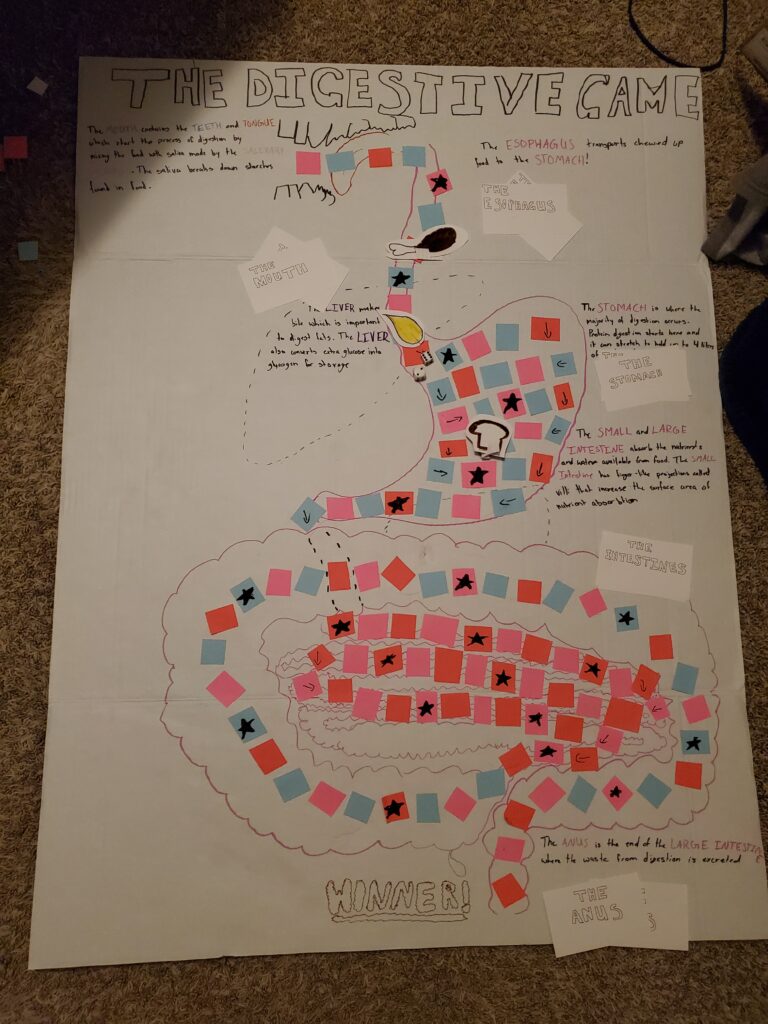

My STEAM Project is a board game that aims to teach the players the order of organ function and path of food during digestion through game play cards and information written on the board. The board itself has different sections (mouth, esophagus, stomach, small intestine, large intestine, anus) which have a brief description of the organ and its purpose in digesting food. There are also outlines of the accessory organs that food does not travel through but still contribute to digestion. The players start by picking a token to use as their play piece. Players can choose between playing as protein, fat or carb which have different perks. Protein’s perk is +1 space to help cards that give extra moves during gameplay because proteins provide amino acids which are the building blocks of the body. Proteins also make up hemoglobin which provide oxygen to the body and tissues. I thought it was fitting that protein gives the player a small boost because of its many purposes. Fat is divide the effect of hinder cards in half because fats contribute to the structure of our cells, are important for hormone production, and are the most calorie dense macromolecule and I thought with it also providing for the structure of the body it should contribute to protecting against hindrances. Carbohydrate is +2 to every movement roll during the actual game because it provides a quick source of energy. I decided not to have anything affect the chronic cards other than the dice roll to teach how the symptoms of a chronic disease can change on a day to day basis. The single die roll being different every turn will show the players that the symptoms can affect the person living with the disease differently and a high roll will represent a high symptom day and a low roll will represent a low symptom day. Players will then take their turns in the order of carbohydrate, fat, and then protein and roll to see how far they move. I chose this order because carbohydrates are a fast digesting energy source, fats digest faster than proteins but are a slower energy source than proteins, and proteins have the longest process to be converted into energy. Similar to The Game of Life there are spaces that represent events. These events are represented by cards that are drawn by each player. Cards are labeled as Chronic, Hinder and Help and are shuffled into the stack that corresponds to their region of the digestive system which is displayed on the non-information side of the card. Chronic cards give the player chronic illnesses and diseases, such as Crohn’s disease, that stay with the player for the rest of the game to show how chronic diseases are for life and there is no cure for a vast majority of them. Hinder gives the player small injuries and illnesses, such as food poisoning, that are over in a turn or two but slow the player down. Help cards give the player a small boost based on healthy habits that promote good digestion and will help and not hinder any of the organs. Each card has a small description of the disease or event on it to explain why it helps, hinders, or is chronic.
Citations
Ha, F., & Khalil, H. (2015). Crohn’s disease: a clinical update. Therapeutic advances in gastroenterology, 8(6), 352–359. https://doi.org/10.1177/1756283X15592585
Clarrett, D. M., & Hachem, C. (2018). Gastroesophageal Reflux Disease (GERD). Missouri medicine, 115(3), 214–218.
Bintsis T. (2017). Foodborne pathogens. AIMS microbiology, 3(3), 529–563. https://doi.org/10.3934/microbiol.2017.3.529


This steam project covers the pathway and functions of the digestive system as well as the functions of each organ themselves. It does this in a fun and interactive way through the form of a board game. The players will start at the beginning of the digestive system (the mouth) and travel all the way to the anus, with details about each function, including the accessory organs like the liver. Throughout the game, there is information explaining what is going on in a specific location.Each player piece represents a macro molecule present in food, including protein, carb, or fat, with each having their own benefit if played through the digestive game. This creates a great way to understand how each macro molecule interacts with the digestive system themselves. In the game, cards are also involved which represent a situation related to the digestive system, including chronic digestive diseases, small digestive illnesses, as well as cards the promote a healthy digestive system.